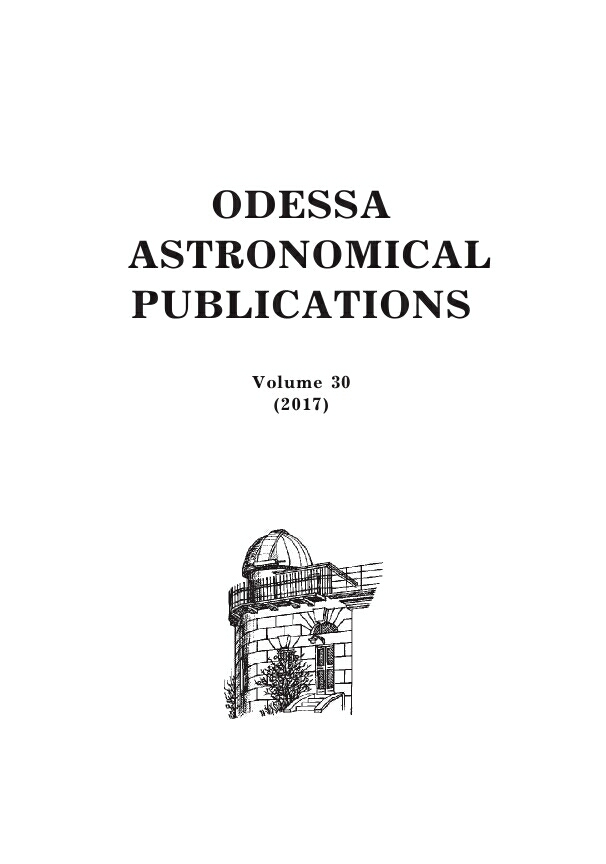STATISTICALLY OPTIMAL MODELING OF FLAT ECLIPSES AND EXOPLANET TRANSITIONS. THE “WALL-SUPPORTED POLYNOMIAL” (WSP) ALGORITMS
DOI:
https://doi.org/10.18524/1810-4215.2017.30.118521Ключові слова:
variable stars, eclipsing binary, minima timings, O-C analysis, TYC 3692-624-1 = Gaia DR1 505352827074254080 = GSC 03692-00624Анотація
The methods for determination of the characteristics of the extrema are discussed with an application to irregularly spaced data, which are characteristic for photometrical observations of variable stars. We introduce new special functions, which were named as the “Wall-Supported Polynomial” (WSP) of different orders. It is a parabola (WSP), constant line (WSL) or an “asymptotic” parabola (WSAP) with “walls” corresponding to more inclined descending and ascending branches of the light curve. As the interval is split generally into 3 parts, the approximations may be classified as a “nonpolynomial splines”. These approximations extend a parabolic/linear fit by adding the “walls” with a shape, which asymptotically corresponds to the brightness variations near phases of the inner contact. The fits are compared to that proposed by Andronov (2010, 2012) and Mikulasek (2015) and modified for the case of data near the bottom of eclipses instead of wider intervals of the light curve. The WSL method is preferred for total eclipses showing a brightness standstill. The WSP and WSAP may be generally recommended in a case of transit eclipses, especially by exoplanets. Other two methods, as well as the symmetrical polynomials of statistically optimal order, may be recommended in a general case of non-total eclipses. The method was illustrated by application to observations of a newly discovered eclipsing binary GSC 3692-00624 = 2MASS J01560160+5744488, for which the WSL method provides 12 times better accuracyПосилання
AAVSO: 2017, https://sites.google.com/site/aavsoebsection/determining-time-of-minimum
Andronov I.L.: 1987, PAICz, 70, 161.
Andronov I.L.: 1994, Odessa Astron. Publ., 7, 49.
Andronov I.L.: 2003, ASPC, 292, 391.
Andronov I.L.: 2005, ASPC, 335, 37.
Andronov I.L.: 2010, Int. Conf. KOLOS-2010 Abstr. Booklet, Snina, Slovakia, 1, http://www.astrokarpaty.net/kolos2010abstractbook.pdf
Andronov I.L.: 2012a, Ap, 55, 536.
Andronov I.L.: 2012b, Częstochowski Kalendarz Astronomiczny 2013, 133, (2012arXiv1212.6707A).
Andronov I.L. et al.: 2003, Astron.Astroph.Trans.,22, 793.
Andronov I.L. et al.: 2014, AASP, 4, 3.
Andronov I.L. et al.: 2017, ASPC, 511, 43.
Andronov I.L., Marsakova V.I.: 2006, Ap, 49, 370.
Andronov I.L., Tkachenko M.G.: 2013, Odessa Astron. Publ., 26, 204.
Andronov I.L., Tkachenko M.G., Chinarova L.L.: 2016, OEJV, 176, 35.
Andronov I.L., Tkachenko M.G., Chinarova L.L.: 2017, Astrophysics, 60, 57.
Andrych K.D., Andronov I.L., Chinarova L.L., Marsakova V.I.: 2015, Odessa Astron. Publ., 28, 158.
BAA: 2011, “Eclipsing Binary Observing Guide”, http://www.britastro.org/vss/EBHandbook11.pdf
Brat L., Mikulašek Z., Pejcha O.: 2012, http://var2.astro.cz/library/1350745528_ebfit.pdf
Breus V.V.: 2003, Odessa Astron. Publ., 16, 24.
Chinarova L.L., Andronov I.L.: 2000, Odessa Astron. Publ., 13, 116.
Devlen A.: 2015, OEJV, 171, 1.
Juryšek J. et al.: 2017, A&A, doi:10.1051/0004-6361/201730655
Kreiner J.M., Kim Chun-Hwey, Nha Il-Seong: 2001, “An Atlas of O-C
Diagrams of Eclipsing Binary Stars”, Cracow, Poland, 2001aocd.book.....K .
Kwee K.K., van Woerden H.: 1956, BAN, 12, 327,
Marsakova V.I., Andronov I.L.: 1996, Odessa Astron. Publ., 9, 127.
Mikulašek et al., 2011, ASPC, 451, 111.
Mowlavi N. et al: 2017, A&A, 606A, 92.
Prša A., Zwitter T.: 2005, ApJ, 628, 426.
Samus’ N.N. et al.: 2017, ARep, 61, 80.
Tkachenko M.G.: 2016, AASP, 6, 73.
Tkachenko M.G., Andronov I.L.: Chinarova L.L.: 2016, JPhSt, 20, 4902
.
Tsesevich V.P.: 1970, “Peremennye zvezdy i sposoby ikh issledovaniia.”, Moskva: Nauka, 240 p. 1970pzsi.book.....T
Tsesevich V.P.: 1971, “Instationary stars and methods of their investigation. Eclipsing variables”, Moskva: Nauka, 352 p. 1971isme.conf.....T
Vanmunster T.: 2015, PERANSO Light Curve and Period Analysis Software. http://www.peranso.com
Zoła S., Kolonko M., Szczech M.: 1997, A&A, 324, 1010.
Zoła S. et al.: 2010, MNRAS, 408, 464.
##submission.downloads##
Опубліковано
Як цитувати
Номер
Розділ
Ліцензія
Авторське право (c) 2017 Odessa Astronomical Publications

Ця робота ліцензується відповідно до Creative Commons Attribution-NonCommercial 4.0 International License.
Відповідно Закону України про авторське право і суміжні права N 3792-XII від 23 грудня 1993 року
